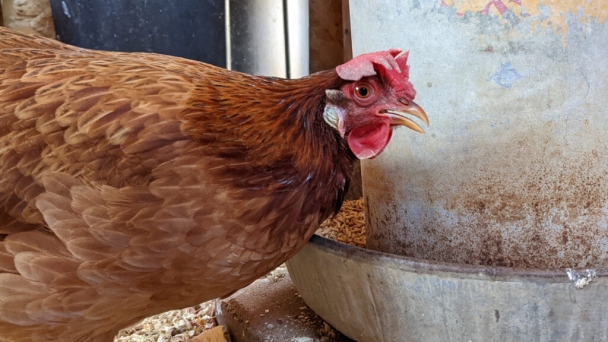Infectious bird flu detected in Dallas County backyard flock

A backyard chicken raised to lay eggs. (Photo by Jared Strong/Iowa Capital Dispatch)
A mixed flock of 48 backyard birds in Dallas County recently contracted a deadly and highly transmissible avian influenza, the Iowa Department of Agriculture and Land Stewardship confirmed on Thursday.
It is the first detected infection among Iowa’s domestic bird flocks since early May, although the virus was found in five hunted and dead wild birds in western and eastern Iowa in September.
“It is not unexpected that we would face additional highly pathogenic avian influenza challenges in Iowa given that the fall migration is underway, and many other states have recently announced confirmed cases,” said Mike Naig, the state’s agriculture secretary.
“We continue to work with impacted producers, (the U.S. Department of Agriculture), and other industry stakeholders to refine and implement our response plans to limit the spread of this virus. Enhanced biosecurity remains the best line of defense to protect animal health,” Naig said.
Since late August, the virus has been found in at least 37 backyard and commercial flocks in Iowa’s neighboring states, according to USDA data. Half of those detections were in Minnesota.
The fall migration through Iowa should be slowing based on historical data, according to the BirdCast forecast by Colorado State University and the Cornell Lab of Ornithology. An estimated 2.6 million birds migrated through Iowa overnight Wednesday. That compares with a peak of about 53 million birds on Oct. 5, although the migration numbers can fluctuate wildly from one day to the next.
The Dallas County bird flu detection was Iowa’s 20th. That includes 15 commercial flocks and five backyard flocks for a total of about 13.4 million birds.
Humans are unlikely to be infected by the virus, and eggs and meat of infected birds are destroyed. Entire infected flocks are culled to keep the virus from spreading to other facilities.
The recurrence of the virus during the fall migration stands apart from the last bout of outbreaks in 2015, and experts are unsure what that means for next year. The virus has recently been a perennial problem in Europe.
“That virus of 2015 that wreaked havoc in the spring kind of petered out in the summer and didn’t come back, and we didn’t see it in the wild birds either, but this time around it’s still here,” said Yuko Sato, a poultry extension veterinarian and diagnostician at Iowa State University. “It’s here to stay until it clears itself out. Might not be this year. Might be next year.”
Iowa Capital Dispatch is part of States Newsroom, a network of news bureaus supported by grants and a coalition of donors as a 501c(3) public charity. Iowa Capital Dispatch maintains editorial independence. Contact Editor Kathie Obradovich for questions: info@iowacapitaldispatch.com. Follow Iowa Capital Dispatch on Facebook and Twitter.
Category:
The Eagle Grove Eagle
The Eagle Grove Eagle
P.O. Box 6
304 West Broadway
Eagle Grove, IA 50533
Phone: 1-515-448-4745
FAX: 1-515-448-3182
Email: news@eaglegroveeagle.com
Mid-America Publishing
This newspaper is part of the Mid-America Publishing Family. Please visit www.midampublishing.com for more information.